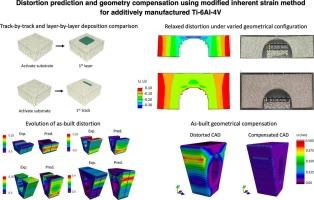使用改进的固有应变法对快速成型的 Ti-6Al-4V 进行变形预测和几何补偿
IF 6.8
1区 工程技术
Q1 ENGINEERING, MANUFACTURING
引用次数: 0
摘要
激光粉末床熔融(LPBF)工艺能够为医疗、航空航天和汽车等各行各业要求高精度的特殊应用生产复杂的几何形状。然而,LPBF 工艺中巨大的热梯度往往会导致残余应力,从而造成明显的变形,并可能导致制造的零件失效。因此,本研究采用一种改进的固有应变方法,对增材制造 Ti-6Al-4V 零件的变形预测和几何补偿进行了研究。与以往研究不同的是,本研究同时考虑了基材去除产生的松弛变形和竣工变形,并结合了具有不同几何特征(如高度和厚度)的试样。该研究旨在全面评估修正固有应变方法在捕捉不同建造方案下的变形方面的功效,并评估几何补偿在最大限度减少竣工变形方面的功效。总体而言,我们发现数值模型能有效捕捉具有不同几何特征的样品的松弛变形,与实验结果显示出合理的一致性。此外,厚度为 5 毫米及以上的样品的竣工变形也得到了很好的预测,数值结果与实验结果之间的平均偏差约为 0.125 毫米。尽管如此,我们注意到了捕捉薄楔形平面外变形所面临的挑战,这为今后的研究提供了途径。此外,几何补偿将最大变形从 0.68 毫米减小到 0.28 毫米,平均变形从 0.15 毫米减小到 0.05 毫米。多次迭代补偿在减少变形方面产生的差异微不足道,这表明对于本研究中探索的几何形状,单次补偿足以减轻变形。总之,这项研究为增材制造 Ti-6Al-4V 组件的变形预测和补偿策略提供了宝贵的见解。本文章由计算机程序翻译,如有差异,请以英文原文为准。

Distortion prediction and geometry compensation using modified inherent strain method for additively manufactured Ti-6Al-4V
A laser powder bed fusion (LPBF) process enables the production of intricate geometries for specialized applications demanding high precision in various industries such as medical, aerospace, and automotive. However, substantial thermal gradients in the LPBF process often led to residual stress, resulting in noticeable distortion and potential part failure of fabricated parts. Therefore, the present work investigates distortion prediction and geometry compensation for additively manufactured Ti-6Al-4V components employing a modified inherent strain method. Unlike previous studies, both relaxed distortions from substrate removal and as-built distortion are considered, incorporating specimens with varying geometrical features such as height and thickness. The study aims to comprehensively evaluate the efficacy of the modified inherent strain approach in capturing distortion under different build scenarios and assess the effectiveness of geometrical compensation in minimizing as-built distortion. Overall, we found that numerical models effectively capture relaxed deflection for samples with varied geometrical features, showing reasonable agreement with experimental results. Additionally, the as-built distortion of samples with thicknesses of 5 mm and above is well-predicted, with an average deviation between numerical and experimental results of approximately 0.125 mm. Nonetheless, we noted the challenge in capturing out-of-plane distortion for thin wedges, suggesting avenues for future investigation. Furthermore, geometry compensation reduces maximum distortion from 0.68 to 0.28 mm and average distortion from 0.15 to 0.05 mm. Multiple iterations of compensation yield insignificant differences in distortion reduction, which suggests sufficient distortion alleviation from single compensation for geometries explored in the present work. Overall, the study provides valuable insights into distortion prediction and compensation strategies for additively manufactured Ti-6Al-4V components.
求助全文
通过发布文献求助,成功后即可免费获取论文全文。
去求助
来源期刊

Journal of Manufacturing Processes
ENGINEERING, MANUFACTURING-
CiteScore
10.20
自引率
11.30%
发文量
833
审稿时长
50 days
期刊介绍:
The aim of the Journal of Manufacturing Processes (JMP) is to exchange current and future directions of manufacturing processes research, development and implementation, and to publish archival scholarly literature with a view to advancing state-of-the-art manufacturing processes and encouraging innovation for developing new and efficient processes. The journal will also publish from other research communities for rapid communication of innovative new concepts. Special-topic issues on emerging technologies and invited papers will also be published.
 求助内容:
求助内容: 应助结果提醒方式:
应助结果提醒方式:


